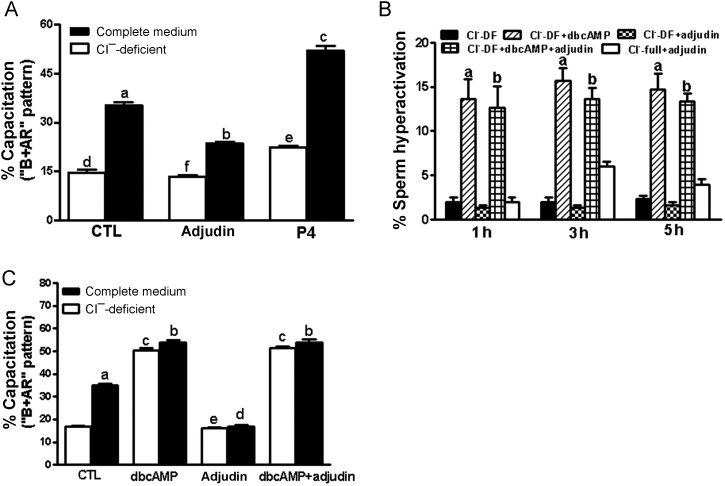Figure 7.
(A) Effect of adjudin on human sperm capacitation in the complete Cl−-HTF medium or the Cl−-DF HTF medium. Sperm were separately incubated for 5 h in the complete Cl−-HTF or Cl−-DF HTF medium with or without 10 μM adjudin under capacitating conditions. The results are expressed as the mean ± SEM (n = 5). a compared with Cl−-DF HTF medium (d), P < 0.001; b versus f, P < 0.01; c versus e, P < 0.001. e versus d, P > 0.05. (B) dbcAMP rescues the inhibition of human sperm hyperactivation induced by adjudin. Sperm were separately incubated for 1–5 h in the complete Cl−-HTF- and/or Cl−-DF HTF medium without or with adjudin (10 μM) in the presence of or the absence of 1 mM dbcAMP. Sperm hyperactivation was evaluated by CASA. The results are expressed as the mean ± SEM (n = 5). a versus b, P > 0.05; a/b when compared with Cl−-DF HTF or Cl−-full HTF alone or plus adjudin, P < 0.001. (C) dbcAMP rescues the inhibition of human sperm capacitation induced by adjudin. Sperm were separately incubated for 5 h in the complete Cl−-HTF medium with or without 10 μM adjudin or in the presence or absence of 1 mM dbcAMP. Sperm capacitation (‘B’ + ‘AR’ patterns) was evaluated by CTC staining. The results are expressed as the mean ± SEM (n = 5). There is no difference in sperm capacitation when treated with dbcAMP in the full HTF or DF-Cl HTF medium in the presence or absence of adjudin. b versus c, P > 0.05; e versus d, P > 0.05, except for a versus CTL, P < 0.001. CTL, control; dbcAMP, dibutyryl cAMP; P4, progesterone.

